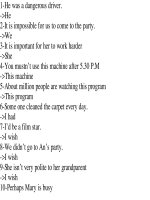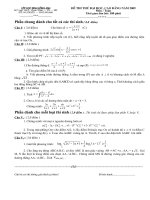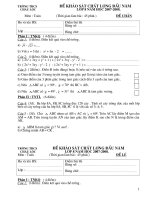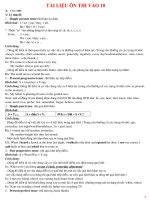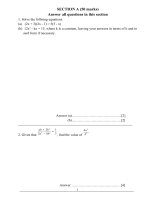Đề Toán Tiếng Anh tham khảo thi vào Raffles Singapore
Bạn đang xem bản rút gọn của tài liệu. Xem và tải ngay bản đầy đủ của tài liệu tại đây (277.95 KB, 10 trang )
SECTION A (50 marks)
Answer all questions in this section
1. Solve the follwing equations.
(a) (2x + 3)(2x - 1) = 5(5 - x)
(b) 12x
2
- kx = 15, where k is a constant, leaving your answers in terms of k and in
surd form if necessary.
Answer (a)……………………………………[2]
(b)……………………………………[2]
2. Given that
3
1
82
2
22
2
=
−
+
ba
bab
, find the value of
2
2
4
b
a
Answer ……………………………………[4]
1
3. Given that 1 - 5x 2
2
29 x−
and 1 2y 6, find the range in which
y
x
must lie.
Answer ……………………………………[4]
4. If x varies directly as the cube of y and the square of y varies inversely as the
cube of z, prove that x
2
z
9
is a constant.
Answer ……………………………………[4]
2
5. In each of the following, the graph of f(x) is given. On the same axes, sketch and
label the graph of g(x). Indicate clearly the x-intercept(s), y-intercept and
asymptote, where applicable.
(a) f(x) = x
2
g(x) = f(x) + 2 [1]
(b) f(x) = x(x - 2)(x - 4) g(x) = f(2x) [2]
(c) f(x) =
x
1
g(x) = f(x - 1) [2]
y
3
6. The line 5y + 4x = 20 cuts the x-axis at P and the y-axis at Q. The point R is the
midpoint of PQ and O is the origin.
Find the equation of
(a) the line through R which is parallel to the y-axis,
(b) the line which is the reflection of the line PQ in the x-axis.
Answer (a)……………………………………[2]
(b)……………………………………[1]
7. In the diagram, AD is the diameter of circle, centre O. The points B and C lie on
the circumference of the circle such that BC is parallel to AD. Given that reflex
∠
AOB = 320
0
, find
(a)
∠
ACB,
(b)
∠
ADC
Answer (a)……………………………………[1]
(b)……………………………………[2]
4
8. The graph below shows how the speed of a car changes as it starts from rest. The
four sections of the graph indicate the speeds in the four gears.
(a) Calculate the distance travelled in the fifst 10s.
(b) On the axes in the answer space, sketch the acceleration-time graph of the car in
the first 26 seconds. [3]
Answer (a)……………………………………[2]
5
9. AD and CD are tangents to the circle, center O. Given that
∠
ADC = 36
0
,
calculate
(a)
∠
ACD
(b)
∠
ABC
Answer (a)……………………………………[1]
(b)……………………………………[3]
6
10. In triangle ABC,
∠
BAC = 120
0
, AB = 3cm and AC = 5cm, caculate
(a) the area of ABC,
(b) the height h, of ABC,
[sin 60
0
= 0.87, cos 60
0
= 0.5, tan 60
0
= 1.73]
Answer (a)……………………………………[2]
(b)……………………………………[3]
C
7
11. A group of 60 pupils took a test.
5
1
of the students obtained not more than
5
2
of
the maximum score.
4
1
of the pupils obtained more than or equal to
10
7
of the
maximum score. The minimum and maximum scoreres were 0 and 100
respectively.
(a) Complete the frequency table below and use it to complete the histogram.
[4]
8
Class (score) Base (Class size) Frequency Frequency Density
0 x < 40 40 12 0.3
40 x < 70 30
70 x 100 30
Frequency density
10 20 30 40 50 60 70 80 90 100
Score
(b) Identify the modal class.
Answer (b)……………………………………[1]
12. A strange chessboard has 4 rows and 2 columns. There are eight 1 x 1 squares
and three 2 x 2 squares on it.
(a) If the chessboard has 5 rows and 3 columns, how many 1 x 1, 2 x 2 and 3 x 3
squares are there on the chessboard?
(b) Complete the table below. [2]
Dimensions of Number of different squares Total number
9
Chessboard
of squares
1 x 1 2 x 2 3 x 3 4 x 4 5 x 5
4 x 2 8 3 11
5 x 3
6 x 4
7 x 5
(c) By using the observed pattern in (b), find the total number of squares of all sizes
on the chessboard if the chessboard has 10 rows and 8 columns.
Answer (a) Number of 1 x 1 squares =………………
Number of 2 x 2 squares =………………
Number of 3 x 3 squares =………………
[1]
(c)…………………………………………[2]
End of selection A
10
